"Animals are my passion. Animals are my life ... Animals are my reason for being," Jennifer Raymond told me as we stood in the shade of an outbuilding at the Mad River Stables in Arcata at the tail end of the recent heat wave. Raymond founded the Humboldt Spay/Neuter Network and her enthusiasm for animals is infectious. Her latest foray into saving her four-legged friends is grazing a stone's throw away in a bright green pasture dotted with yellow flowers. Her name is Glory Be, and she is a pinto mustang that Raymond purchased for $15 dollars at a Bureau of Land Management horse sale in Burns, Ore., last year. The horse was headed to a buyer in the Midwest, she says, along with 49 other over-10-year-old mustangs. "That just [made] me really nervous," she said. "What does anybody want with 50 over-10-year old mustangs?" And so Glory Be ended up in a field on the North Coast rather than on a charcuterie plate somewhere in France.
Another thing that's turning 10 this year is California's ban on horse slaughter. In 1998 the Prohibition of Horse Slaughter and Sale of Horsemeat for Human Consumption Act passed into law with the largest percentage of votes (60 percent) of any California animal protection initiative. But over the past decade the ban has caused unintended damage to California's and by extension Humboldt's equine economy, by lowering the price of horses. Before, horses always had a minimum per-pound value. Now, with the market flooded with animals that would have ended up in a slaughterhouse 10 years ago, supply is outstripping demand and that's hurting horse breeders' bottom line.
Raymond admits that there's an inherent irony with a society that condones the consumption of cattle and other livestock but makes an exception for horses. "If I were a meat eater," she said, "I'd say it's really hypocritical of me to condemn slaughtering horses for food when we slaughter cows and sheep." But Raymond, who taught vegetarian cooking for 20 years, is not an omnivore. "I personally don't want to take any animal's life for my food source," she said.
For Raymond, like for many Californians, horses are an indelible symbol of the American West. And they occupy a fuzzy region between pets and livestock: not as compact as a dog, but equally loveable. And certainly not intended for human consumption. "People have this mental and emotional attachment to horses," Richard W. Wilcke, director of the University of Louisville's Equine Industry Program, told me recently from his office in Kentucky. "And you combine that with the fact that we have a long standing cultural taboo not to eat horse meat." What you get is legislation like California's, and the recent closure of America's last remaining horse abattoirs in Texas and Illinois. But horse slaughter isn't going to go away — the $26 million dollar a year business has merely moved away. Horses are now shipped out of the country to Canada and Mexico, where the USDA doesn't control what methods — humane or not — are used to slaughter them.
A white paper prepared for the Animal Welfare Council in 2006 by almost a dozen Ph.D.s, including economists and veterinarians from the country's leading Ag schools, addresses the unintended consequences of banning horse slaughter. The paper argues that if the 1 percent of America's horses that usually end up going to slaughter are kept alive, not only will that increase the population of unwanted and neglected horses, but it will also lower horse sale prices in general and increase the strain on horse rescue facilities — both of which are already happening locally.
On a recent Wednesday afternoon at the Humboldt Auction Yard, Lee Mora presided over his cowboy-boot-and-cowboy-hat-clad flock of local ranchers. Ascending prices cascaded off his tongue effortlessly. Cows lowed and spun in the central corral. The cool air in the windowless interior of the auction yard was a fragrant mix of manure and mulch, with sweet undertones of grain feed. There was only one thing missing: horses.
But that's nothing new. Mora hasn't sold horses at his auction for about a decade. He says he stopped after California passed legislation banning horse slaughter because he knew that most of the animals he sold were headed into the food chain. Mora insists that the sale of cull horses — those destined for slaughter — didn't provide significant revenue for the auction; rather it was a service he provided to his clientele — mostly cattlemen — when they needed to get rid of unwanted horses. The auction, he says, served as a "facilitator ... to our producers to turn these horses over humanely, and they would go through the meat supply — much more humane than the situation we have now." Other Northern California auctions, who continue to sell horses, aren't as punctilious.
NorCal Equine Rescue, which claims to be the largest non-profit horse rescue group in California, based in Oroville, has rescued over 500 horses since it was founded in 2003. Tawnee Preisner, who founded the organization with her husband, told me in a recent phone interview that at the last livestock auction she attended in the Central Valley she counted seven killer buyers in the stands. She says that even though it's illegal to sell horses by the pound in California, killer buyers purchase horses by the head at a price that works out to as much as 50 cents per pound. "The law is there but they don't care," she says of the auction yards and the buyers. As for the California Department of Food and Agricultural, the agency you'd think would be in charge of enforcing the horse slaughter ban, all they do, according to an agency spokesperson, is inspect state-licensed slaughter facilities to ensure they're not processing horses.
In fact, it's hard to put a finger on who exactly is in charge of enforcing the ban. Brand inspectors in Oregon and California say they don't check horses being transported northward across the border. East of here, in Fallon, Nev., and up north in Hermiston, Ore., pound horses are being sold at auction regardless of whether they originate in the Golden State, and later transported to foreign slaughterhouses. At present, groups opposed to horse slaughter are lobbying for federal legislation that would make transporting horses for the purposes of slaughter illegal, but such a law doesn't exist yet.
Preisner admits that the ban on horse slaughter in California has affected horse breeders by lowering the overall price of horses sold at auction, but she explains that "in the long run it's going to be better for the horses and the horse market." Better for the horses because fewer animals will end up slaughtered, and better for the horse market because eventually, after the number of horse breeders is reduced, the equine economy will balance itself out again. (Many of the agricultural economists I spoke to for this article agreed that in the long run the ban on horse slaughter will translate into fewer horses, but at the cost of horse-related jobs.)
The extra strain on horse breeders is one of the reasons why Preisner thinks there ought to be an economical option for disposing unwanted and/or injured horses. Now it costs about $500 to have a horse put down and hauled away, according to a local veterinarian. Three or four years ago, the local tallow plant charged much less to come and pick up a horse for processing, but they've since gone out of business. Preisner suggests creating government-subsidized euthanasia clinics.
Lee Mora bristles at the thought of the government getting involved in the horse business. He'd rather leave things up to market forces. But with a ban on slaughter, the market is already not as free as it used to be. That's because slaughter provided a natural, cost-effective mechanism for culling unwanted horses from the herd.
"Horse people are reluctant to try horses anymore because there is no bottom," Mora said over the phone early one recent morning. "Not only is there no value to them, you have to dispose of them yourself. Because of that, the whole horse market has crashed."
The Animal Welfare Council white paper estimates that eliminating the possibility of selling a horse for processing decreases the value of horses in general by approximately $304 per head. But local ranchers say it's even worse than that. In many cases, horses are being given away or simply dumped in a field somewhere. Or they end up in a horse rescue like the one Sara Isaacson runs.
Isaacson started the Heart of the Redwoods Horse Rescue group in Humboldt in 2003. But she rescued her first horse from slaughter in 1998: Sonny was still grazing somewhere in a nearby pasture when we spoke over the phone recently. Isaacson recognizes that there has been a major shift in Humboldt's equine economy, but she attributes it less to the ban on slaughter and more to the rising costs of alfalfa hay (up more than 50 percent per ton from last year) and diesel fuel.
"I don't think the ban on slaughter has been the key issue," she said. "I think the cost of keeping the horse has been the key issue."
For that reason, Heart of the Redwoods emphasizes educating potential horse buyers about the real costs of raising and breeding horses before they end up abandoning them for financial reasons. As it is, there are too many abandoned and neglected horses for Isaacson to take care of. The recent seizure of 40 neglected horses in Myers Flat has "totally depleted us," she said.
Isaacson predicts that in the future there are going to be a lot fewer horses in Humboldt County. "I think that people will come to realize that buying a horse for their daughter is not a quick fix," she said. "I think you're going to find more facilities that are leased facilities, where you can come and take a lesson or ride on a trail. That's what you see in San Francisco."
Admittedly, it also means that some old-time ranchers will find themselves out of a job. "For so many ranchers, their profit margin is so small that they've really had to look at horses and their usability," she said.
Ray Christie is a hard guy to get a hold of. With almost 2,000 acres spread around Humboldt County and livestock ranging from poultry to cattle to miniature horses, he's always busy taking care of something. Lucky for him, he doesn't depend on horses for his livelihood. If that were the case, he says he'd be out of a job. Instead, Christie makes his money buying and selling cattle.
"If I had to buy hay for [all] these horses, I'd go broke," he told me on a recent weekend. The two of us were standing beside his huge, red Dodge truck. In a field just across the road, over 50 head of horses grazed blissfully unaware of the state of Humboldt's equine economy: gray, sorrel, dun, black. You name it, Christie's got it.
The burly, mustachioed rancher told me that almost a dozen of the horses out in the pasture had been dumped there by people who, he assumes, couldn't afford them anymore. Every once in a while, he'll come out and notice new additions. Since he doesn't have to pay for feed, he can keep as many as the field can sustain. And the horses, it turns out, have proven unexpectedly useful. The pasture wasn't always this nice, he said. The horses have eaten back the tussock grass, and they even nibble on the willow branches. They've made it so that he can run his cattle here, and that's good for business. But the connection between his swelling herd and the decline in the local horse economy is undeniable, and, according to Christie, it all leads back to the ban on horse slaughter.
"The horse market has definitely been impacted," he said. A decade ago the killer market kept the prices of regular working horses higher, he told me. "It was nothing to get over $1,000 for a killer horse." And now? "Free," he said. "That's how bad it is."
Christie also thinks it's helped to push up the price of horse hay. He figures that with the increase in the number of horses (due to more unwanted and neglected horses) the demand for feed has gone up, which has led to hay shortages and higher prices. The problem has been compounded by the rising cost of fuel.
From the perspective of a livestock breeder, Christie sees another deleterious consequence of the ban: "What the rescue place is doing is they're taking a lot of these horses that are inferior, that have something wrong with them, and adopting them out," he said. "Well, a lot of these guys are going to breed them, if they're mares, and they're going to get inferiors foals." Slaughter, on the other hand, allowed horse breeders to cull out the biters and kickers, as Christie put it.
As for the old-time horseman, Christie worries his days are numbered: Once upon a time "he could take a young $500 horse and break it and turn around and sell that thing for anywhere from $1,000 all the way up to $4,000 depending on what the horse was. Now you can't do that. And if the horse didn't turn out the way he wanted, at least he had the alternative of sending that thing to kill. Now if it don't turn out, [he's] stuck. [He] has to pay $500 to have the thing put down."
Unfortunately,it's hard to calculate the exact financial impact the ban has had. The Humboldt County agricultural commissioner doesn't include horse production data in its crop report, which does, for example, include data on cattle. The Farm Bureau doesn't collect information about the county's horses either.
"There are just so few data available on the so-called horse economy," James Leiby, associate professor of economics, told me recently from his office at the University of Maine. Leiby's research was once focused on the equine economy, but there just wasn't enough data out there for him to work with.
What little information we do have is compiled by the American Horse Council. According to their last report, released in 2005, California's horse industry produced goods and services valued at $4.1 billion. The number of Californians involved in that industry, from owners to veterinarians, was 311,100, and there were more than twice that many horses (698,000) in the state. As for the number of full-time jobs the industry provided, the AHC estimated that number to be over 50,000.
But for the most part, people who are paying attention to horses are concerned with the racehorse industry. "No one is looking into the economics of ranchers and their horses," economist James Ahern of Cal Poly told me recently. Ahern coauthored the Animal Welfare Council white paper. He explained the way the equine economy has been affected by the slaughter ban in purely economic terms, saying that if a horse is an asset you have to ask yourself "What's its scrap value?" By banning slaughter, horses essentially lost their scrap value.
Ahern's ability to analyze the situation dispassionately contrasts sharply with Jennifer Raymond's animal enthusiasm. During the writing of this article, her horse Glory Be gave birth to a foal, Freedom. It's ironic that someone who has devoted so much of her life to spaying and neutering cats and dogs unknowingly adopted a pregnant mustang from the BLM — and the irony is not lost on Raymond — but she couldn't be happier about how things have turned out. She saved two horses instead of one.
Though Raymond would like to see an end to the slaughter of all American horses across the borders in Canada and Mexico, she says, "There are only so many things I can save in the world and I'm having to pick and choose these days." For now, she's focusing her energy on the BLM's Wild Horse and Burro program, which she considers to be inefficiently run, and which, according to her, doesn't always act in the best interest of what she considers to be one of the West's greatest treasures — its wild horses. The BLM spends $38.8 million on wild horses and burros annually. About half of that goes to maintaining short- and long-term facilities for the animals. Raymond hopes to see horses like Glory Be, who are over 10 years old, protected from killer buyers. She suggests returning to an adoption-only procedure, which is what the BLM already does for its younger horses. If you buy a horse you have to keep it for a year and the BLM checks up on the animal, which makes selling it for slaughter economically unfeasible. Raymond would also like the BLM to gather fewer horses so as to lower facilities costs, and to use birth control to keep its wild herd population down.
When it comes to the local horse population, people on both sides of the slaughter issue seem to agree on one thing: A reduction in the number of local horses would help. How to make that happen is the contentious part. For those opposed to slaughter, a drastic reduction in the number of horse breeders seems to be the best answer. But that leaves ranchers scratching their heads, wondering why things can't go back to the way they were when selling unwanted horses by the pound was an easy, unregulated way to keep populations down and prices up. It also helped maintain local jobs, which — as an unintended consequence of the now decade-long ban on horse slaughter — may end up meeting the same fate California's unwanted horses once did.
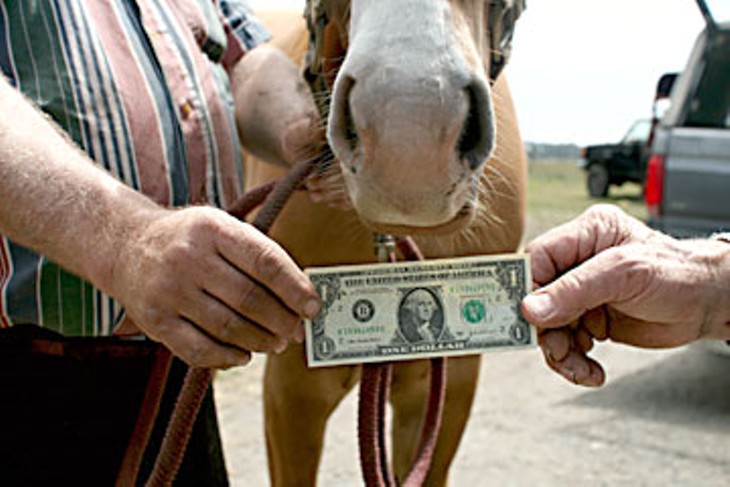
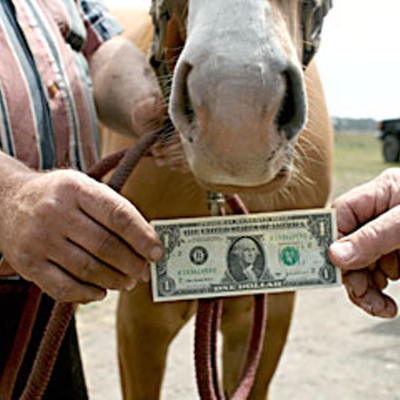
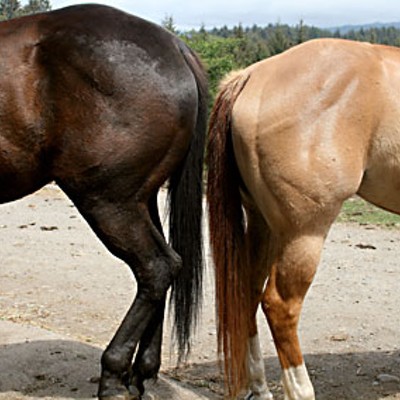
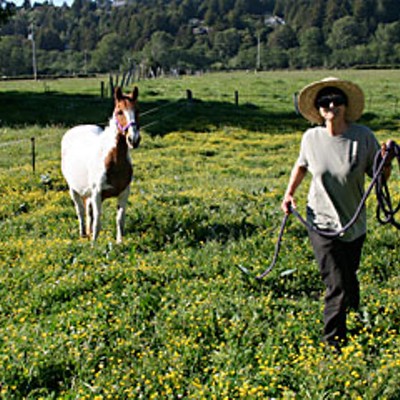
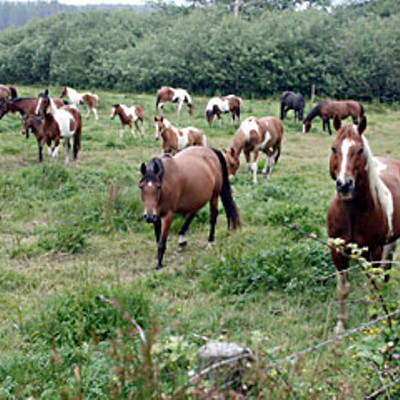
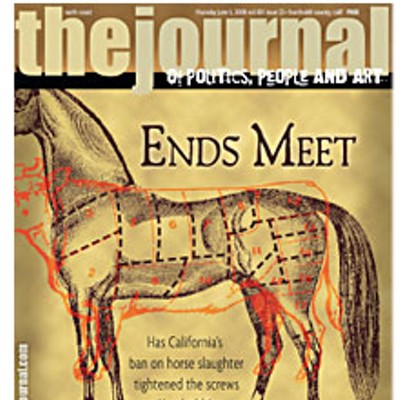

Comments (9)
Showing 1-9 of 9